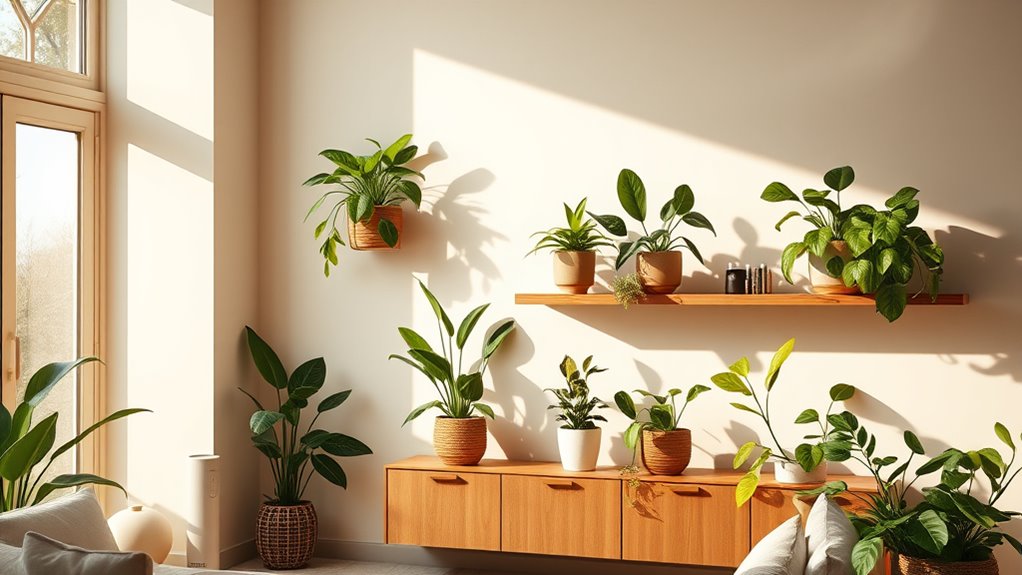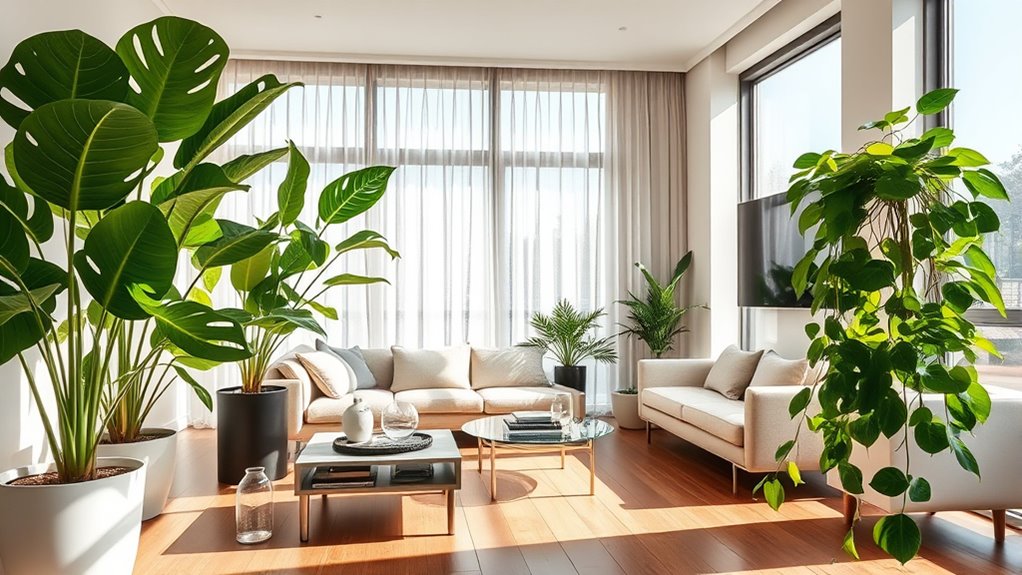Indoor plants can help improve air quality by reducing certain VOCs like formaldehyde, benzene, and xylene, but their effectiveness depends on the plant species and placement. Some plants, like the spider plant, snake plant, and pothos, are more proven in VOC absorption. Keep in mind, plants shouldn’t be your only solution—proper ventilation and source control are essential. Want to discover how to choose the best plants and maximize their benefits? Keep exploring to learn more.
Key Takeaways
- Indoor plants can reduce certain VOC levels but their effectiveness depends on species and proper selection.
- Plants like spider plant, snake plant, and pothos are proven for VOC absorption, especially in polluted environments.
- They work best when combined with good ventilation and source control, not as sole air purification methods.
- The extent of VOC removal varies; plants are a helpful addition but not a complete solution for indoor air quality.
- Realistic expectations are essential; plants support, but do not replace, other air cleaning strategies like purifiers and source reduction.

Indoor plants are often praised for their ability to improve air quality, but they can also interact with volatile organic compounds (VOCs) present in your home. While many believe that adding plants automatically leads to cleaner air, the reality is more nuanced. The key lies in understanding how plants contribute to air purification and how you can optimize your plant selection to make the most of this benefit.
Indoor plants can improve air quality, but their effectiveness depends on species and proper selection strategies.
When considering air purification, it’s important to recognize that not all plants are equally effective at removing VOCs. Some species are known for their ability to absorb common indoor pollutants like formaldehyde, benzene, and xylene. For example, the spider plant, snake plant, and pothos are often recommended because they have demonstrated the ability to reduce certain VOC levels in controlled studies. Your choice of plants should be guided by their proven capacity to interact with these harmful compounds. Selecting the right plants means doing a bit of research, focusing on species with a solid track record in air purification. It’s not just about aesthetics; it’s about choosing plants that actively contribute to healthier indoor air.
Plant selection also involves considering the size of your space and the specific VOCs present. If your home is filled with new furniture, carpets, or paints, you might want to prioritize plants known for their VOC absorption abilities. Conversely, if your home has minimal sources of indoor pollutants, a broader variety of decorative plants can still offer aesthetic and psychological benefits without necessarily impacting air quality considerably. Keeping in mind the plant’s size, growth rate, and maintenance needs can help you maintain a healthy, vibrant indoor garden that supports your air purification goals.
However, it’s essential to set realistic expectations. While plants can help reduce certain VOCs, they shouldn’t be relied upon as the sole method of air purification. Proper ventilation, reducing pollutant sources, and using air purifiers may still be necessary for all-encompassing indoor air quality management. The presence of plants should complement these strategies rather than replace them.
Frequently Asked Questions
Can Plants Completely Eliminate VOCS From Indoor Air?
You might wonder if plants can fully eliminate VOCs from your indoor air. While plant growth helps reduce certain VOC types, they can’t completely remove all pollutants. Plants can absorb some VOCs through their leaves and roots, but their effectiveness depends on factors like plant type and air circulation. So, while they improve air quality, relying solely on plants won’t fully clear every VOC from your space.
Which Specific Indoor Plants Are Most Effective at Removing VOCS?
You’re wondering which plant varieties are most effective at removing VOCs. While no plant can eliminate all low VOCs completely, some species like snake plants, pothos, and spider plants are known for their air-purifying qualities. Incorporating these popular indoor plants can improve air quality, but keep in mind they work best alongside good ventilation and other air-cleaning methods. Choose the right varieties to boost your indoor environment naturally.
How Long Does It Take for Plants to Improve Indoor Air Quality?
You might wonder how long it takes for your indoor plants to improve air quality. It depends on their growth rate and air circulation around them. Faster-growing plants can start making a difference in a few weeks, especially if you guarantee good air flow. Regular watering, proper lighting, and maintaining healthy plant growth help maximize their air-purifying effects, so give your plants time and proper care to see noticeable improvements.
Do Plant Size and Number Significantly Impact VOC Removal?
You might wonder if plant size and number really matter for VOC removal. Larger plants with more extensive growth have bigger leaf surfaces, which can absorb more VOCs. Additionally, having multiple plants improves air circulation around them, enhancing their effectiveness. So, yes, increasing plant size and quantity can considerably boost VOC removal by maximizing leaf surface area and promoting better air flow.
Are There Any Health Risks Associated With Certain Indoor Plants?
You might wonder if certain indoor plants pose health risks. Some plants have toxicity concerns, especially if you have pets or small children who might ingest them. Others can trigger allergenic reactions, like sneezing or skin irritation. It’s smart to research specific plants before bringing them inside, ensuring they’re safe for your environment. Being aware of these risks helps you enjoy your indoor garden without compromising your health.
Conclusion
While indoor plants can help reduce VOCs, they’re not a magic wand that clears the air completely. Think of them as gentle gardeners, quietly working behind the scenes, rather than superheroes saving the day. To truly breathe easier, combine plants with good ventilation and smart cleaning habits. Remember, just like a symphony needs all instruments, a healthy indoor environment relies on multiple efforts working together—plants included, but not solely responsible.









